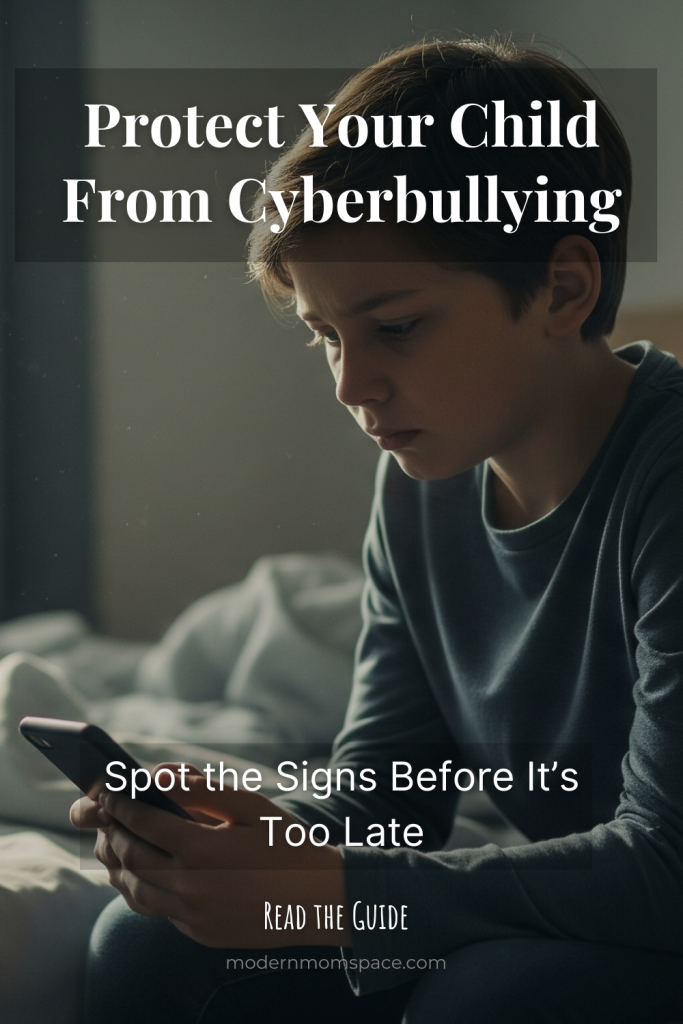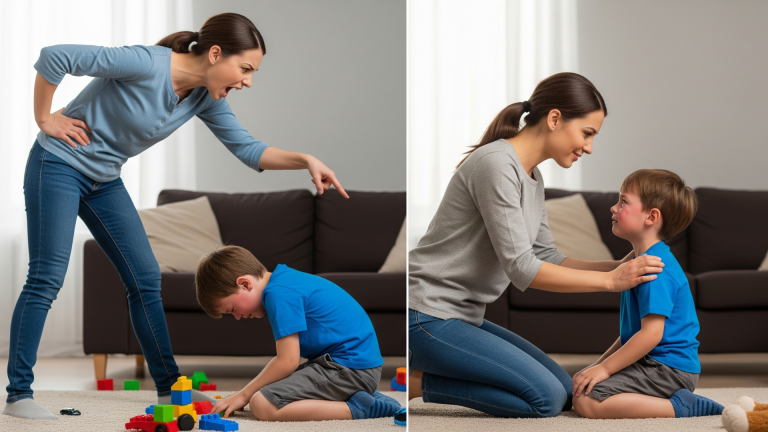Cyberbullying and Your Child: What Parents Need to Know
Picture this. Your kid is laughing at something on their phone at 9 p.m. By 10 p.m., the smile is gone. The phone is face down. “I’m fine,” they say, and head to bed. The next morning, they don’t want to go to school.
That shift can be a tell. Cyberbullying is now one of the biggest hidden risks kids face online. Nearly half of U.S. teens say they’ve been harassed or bullied online at least once, and roughly one in four report being cyberbullied in just the past month. (Pew Research Center)
Reality check. Teens are more connected than ever. Almost half say they’re online “almost constantly,” which means bullying doesn’t end when the bell rings. It follows them home, to the dinner table, and into bed.
What Is Cyberbullying? (Cyberbullying Meaning Explained)
What is cyberbullying? A simple, parent-friendly definition: cyberbullying is repeated, intentional harm done through digital devices and platforms. It can be direct insults in DMs, public pile-ons in group chats, cruel memes, fake accounts, or a steady drip of exclusion and rumor. That “repeated” and “intentional” piece matters. A single awkward comment isn’t cyberbullying. A pattern is.
How it differs from schoolyard bullying. Traditional bullying is limited by time and place. Cyberbullying is always on, potentially public, and it scales fast. Screens give bullies reach and perceived anonymity. It’s also easier for others to join in. That makes it harder for kids to escape and harder for adults to spot.
It ties directly into how kids use their devices. If you’re not sure what ‘screen time’ actually means today, here’s [What Is Screen Time, Really?] for a breakdown parents can use.
Why it’s harder to spot. Kids often hide it. Posts get deleted. Stories expire. Accounts go private or vanish. And a lot of it happens where adults aren’t looking: group chats, gaming voice channels, and disappearing messages. Guidance from national prevention resources confirms this invisibility problem and explains how to respond. (StopBullying.gov)
Two lines to remember.
“Harm, on purpose, over time.”
“If it follows them through a screen, it counts.”
Cyberbullying Examples Parents Should Know
You don’t need to be on every app to recognize the patterns. Common cyberbullying examples:
Recent large-scale teen surveys show how common this is: about 27 percent report cyberbullying in the last 30 days, and more than half say they’ve experienced it at some point. Girls report higher rates, and appearance-based harassment is common. (Cyberbullying Research Center)
Fast test.
If it would be clearly cruel face-to-face, it’s cruel online. No special rules.
Warning Signs Your Child May Be Experiencing Cyberbullying
Emotional red flags
Behavioral red flags
Physical red flags
Prevention experts emphasize that many warning signs center on how a child uses their device: sudden spikes or drops in use, secrecy, and big emotional reactions while on the device.
Why kids hide it. Kids fear losing their phone, being seen as “dramatic,” or making it worse by “snitching.” Some blame themselves. Others think parents will overreact. All of that pushes the problem underground. You need a plan that protects, not punishes.
The rule to say out loud.
“If you tell me something upsetting happened online, I will not take your phone away as my first move.”
How to Talk to Your Child About Cyberbullying
Start before there’s a crisis. Casual, ongoing check-ins beat interrogations.
Try these prompts:
Keep your stance calm and curious. You’re building a channel, not conducting a sting operation. If they share something concerning, thank them first. Then move to facts.
Script you can use.
“Thanks for telling me. I’m glad you didn’t sit with this alone. Let’s save what we need to save. We’ll block and report if needed. We’ll decide together what to share with school. Your phone is staying with you. I’m on your side.”
Global child-safety organizations echo this approach: involve a trusted adult, avoid engaging with harassers, document, and escalate through official channels when needed.
One minute check-in.
At pickup or bedtime, ask, “Any weird drama in your online world today?” Then stop talking. Let them fill the silence.
What Parents Can Do If Your Child Is Cyberbullied
When something crosses the line, you need a calm, step-by-step playbook. Here it is.
Step 1. Pause, then capture evidence.
Screenshots of posts, DMs, usernames, time stamps. Save links. If the content is likely to disappear, record your screen. Keep a dated log of incidents.
Step 2. Coach “no engagement.”
Do not reply, argue, or threaten. Don’t ask friends to retaliate. Responding often feeds the dynamic. Silence plus reporting is more effective.
Step 3. Block and report inside the app.
Every major platform has harassment policies and in-app reporting. Use them. Abusive accounts can get warnings, suspensions, or bans. National prevention resources lay out reporting steps and point to platform-specific guides.
Step 4. Loop in the school when peers are involved.
Give the counselor or administrator your evidence. Be specific: dates, accounts, and impact on school participation. Ask for a safety plan. Schools cannot discipline off-campus speech just because it is rude, but they generally must respond if it creates a hostile environment that affects learning.
Step 5. Consider law enforcement in serious cases.
Threats of violence, stalking, sexual exploitation, hate crimes, and doxxing can be illegal. If the bullying overlaps with harassment based on race, color, national origin, sex, disability, or religion, federal civil rights protections may apply. Guidance from official sources explains where bullying overlaps with harassment covered by federal law.
Step 6. Support your child emotionally.
Name what happened. Separate their identity from the incident. Rebuild routine: sleep, meals, movement, in-person time with safe friends. Consider reducing optional screen time while keeping essential connections. If there are signs of persistent sadness, anxiety, or self-harm, move to professional help.
Why the urgency. Bullying and cyberbullying are linked to higher rates of persistent sadness, hopelessness, and suicidality. Recent national survey work connects frequent social media use with greater bullying victimization and mental health risk among high school students.
The parent posture.
Be the thermostat, not the thermometer. You set the temperature. Calm and firm beats hot and reactive.
Preventing Cyberbullying Before It Starts
You can’t bubble-wrap the internet, but you can change the odds.
A. Set family tech rules that actually stick.
B. Teach digital boundaries and empathy.
C. Use parental controls as part of a bigger strategy.
Controls help with time limits, app approvals, and content filters. They do not replace relationship, coaching, and values. Update settings quarterly. Walk your child through what each setting does and why.
D. Build a resilience network.
Make sure your child has multiple safe adults: you, another parent, a coach, a counselor. Encourage offline belonging: clubs, sports, faith communities, volunteering. When online identity is the only identity, online injuries hit harder.
E. Teach platform literacy.
Show them how to block, report, mute words, limit who can tag them, turn off read receipts, and control who can join group chats. Make them the administrator of their own safety features. National resources provide step-by-step prevention and reporting guidance you can revisit with them.
Five-minute drill.
Tonight, ask your kid to show you how to block and report on their top two apps. Let them teach you. Kids remember what they teach.
When to Seek Professional Help
Call in backup if you see any of the following for more than two weeks:
Start with the school counselor or pediatrician. Ask for evidence-based therapy options in your area. If there are any safety concerns, escalate immediately. National pediatric and public health guidance emphasizes balanced media use, strong offline supports, and prompt attention to worsening mental health.
One sentence to say today.
“If something online scares you or makes you feel small, you can borrow my calm.”
FAQs on Cyberbullying
Q1. How common is cyberbullying?
Pretty common. In a national 2023 sample, about 27 percent of teens reported being cyberbullied in the previous 30 days, and more than half said they’d experienced it at some point. A 2022 survey from Pew found nearly half of U.S. teens had been harassed or bullied online. Rates are higher for teen girls and often tied to appearance.
Q2. Can cyberbullying happen in gaming?
Absolutely. Voice chat, friend requests, party invites, and guild servers can turn toxic fast. Harassment, slurs, griefing, doxxing, and coordinated pile-ons are all documented. The same rules apply: capture evidence, block and report, loop in adults. Many kids experience their most intense harassment in gaming spaces because moderation is uneven and groups are tight-knit. Use platform privacy controls and voice-chat settings. National prevention resources treat gaming harassment as cyberbullying and recommend the same response steps.
Q3. Is cyberbullying a crime?
Sometimes. Cyberbullying overlaps with several laws, especially when it includes credible threats, stalking, sexual exploitation, extortion, or harassment based on protected characteristics like race, sex, disability, or religion. Schools and platforms have policies, and federal civil rights protections can apply if the harassment targets a protected class. For specifics, check your state’s laws and your school’s code of conduct. Government resources outline when bullying behavior crosses into discriminatory harassment covered by federal law.
Q4. Should I take away my child’s phone?
Not as a first move. Kids often stay silent because they’re afraid you’ll confiscate the device. Start by securing safety: document, block, report, loop in school if needed. You can reduce optional screen time and turn off nonessential apps temporarily, but keep core communication open. The goal is coaching, not isolation. International child-safety guidance supports involving a trusted adult, documenting, and escalating, rather than punishing the victim with a device ban.
Try this instead.
Tell your kid, “Your phone stays with you. We’ll adjust settings together.”
Takeaway / Closing
Cyberbullying is real, but parents are not powerless. You don’t need to memorize every trend to keep your child safe. You need a stance and a plan.
If you do those things consistently, you’re already ahead of most families. Your child learns that their online world is talk-about-able, that you’re a safe place to land, and that you’ll act with them, not against them.
One last line worth saying today.
“I’m always on your team, online and off.”
Keep Exploring
If you found this guide on cyberbullying helpful, you might also want to check out these related reads:








